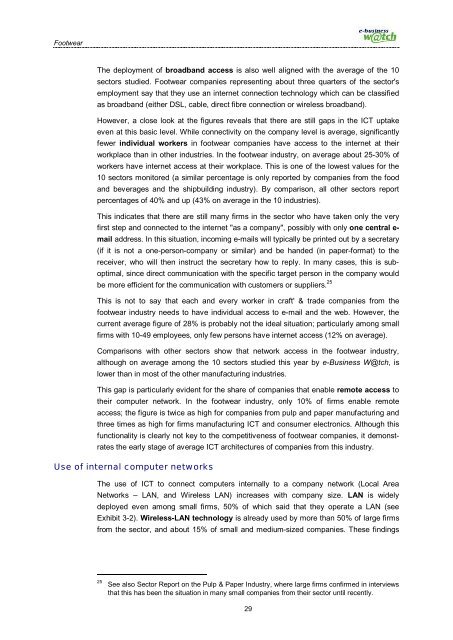Footwear Industry Footwear Industry - empirica
Footwear Industry Footwear Industry - empirica
Footwear Industry Footwear Industry - empirica
Create successful ePaper yourself
Turn your PDF publications into a flip-book with our unique Google optimized e-Paper software.
<strong>Footwear</strong><br />
The deployment of broadband access is also well aligned with the average of the 10<br />
sectors studied. <strong>Footwear</strong> companies representing about three quarters of the sector's<br />
employment say that they use an internet connection technology which can be classified<br />
as broadband (either DSL, cable, direct fibre connection or wireless broadband).<br />
However, a close look at the figures reveals that there are still gaps in the ICT uptake<br />
even at this basic level. While connectivity on the company level is average, significantly<br />
fewer individual workers in footwear companies have access to the internet at their<br />
workplace than in other industries. In the footwear industry, on average about 25-30% of<br />
workers have internet access at their workplace. This is one of the lowest values for the<br />
10 sectors monitored (a similar percentage is only reported by companies from the food<br />
and beverages and the shipbuilding industry). By comparison, all other sectors report<br />
percentages of 40% and up (43% on average in the 10 industries).<br />
This indicates that there are still many firms in the sector who have taken only the very<br />
first step and connected to the internet "as a company", possibly with only one central e-<br />
mail address. In this situation, incoming e-mails will typically be printed out by a secretary<br />
(if it is not a one-person-company or similar) and be handed (in paper-format) to the<br />
receiver, who will then instruct the secretary how to reply. In many cases, this is suboptimal,<br />
since direct communication with the specific target person in the company would<br />
be more efficient for the communication with customers or suppliers. 25<br />
This is not to say that each and every worker in craft' & trade companies from the<br />
footwear industry needs to have individual access to e-mail and the web. However, the<br />
current average figure of 28% is probably not the ideal situation; particularly among small<br />
firms with 10-49 employees, only few persons have internet access (12% on average).<br />
Comparisons with other sectors show that network access in the footwear industry,<br />
although on average among the 10 sectors studied this year by e-Business W@tch, is<br />
lower than in most of the other manufacturing industries.<br />
This gap is particularly evident for the share of companies that enable remote access to<br />
their computer network. In the footwear industry, only 10% of firms enable remote<br />
access; the figure is twice as high for companies from pulp and paper manufacturing and<br />
three times as high for firms manufacturing ICT and consumer electronics. Although this<br />
functionality is clearly not key to the competitiveness of footwear companies, it demonstrates<br />
the early stage of average ICT architectures of companies from this industry.<br />
Use of internal computer networks<br />
The use of ICT to connect computers internally to a company network (Local Area<br />
Networks – LAN, and Wireless LAN) increases with company size. LAN is widely<br />
deployed even among small firms, 50% of which said that they operate a LAN (see<br />
Exhibit 3-2). Wireless-LAN technology is already used by more than 50% of large firms<br />
from the sector, and about 15% of small and medium-sized companies. These findings<br />
25<br />
See also Sector Report on the Pulp & Paper <strong>Industry</strong>, where large firms confirmed in interviews<br />
that this has been the situation in many small companies from their sector until recently.<br />
29

















